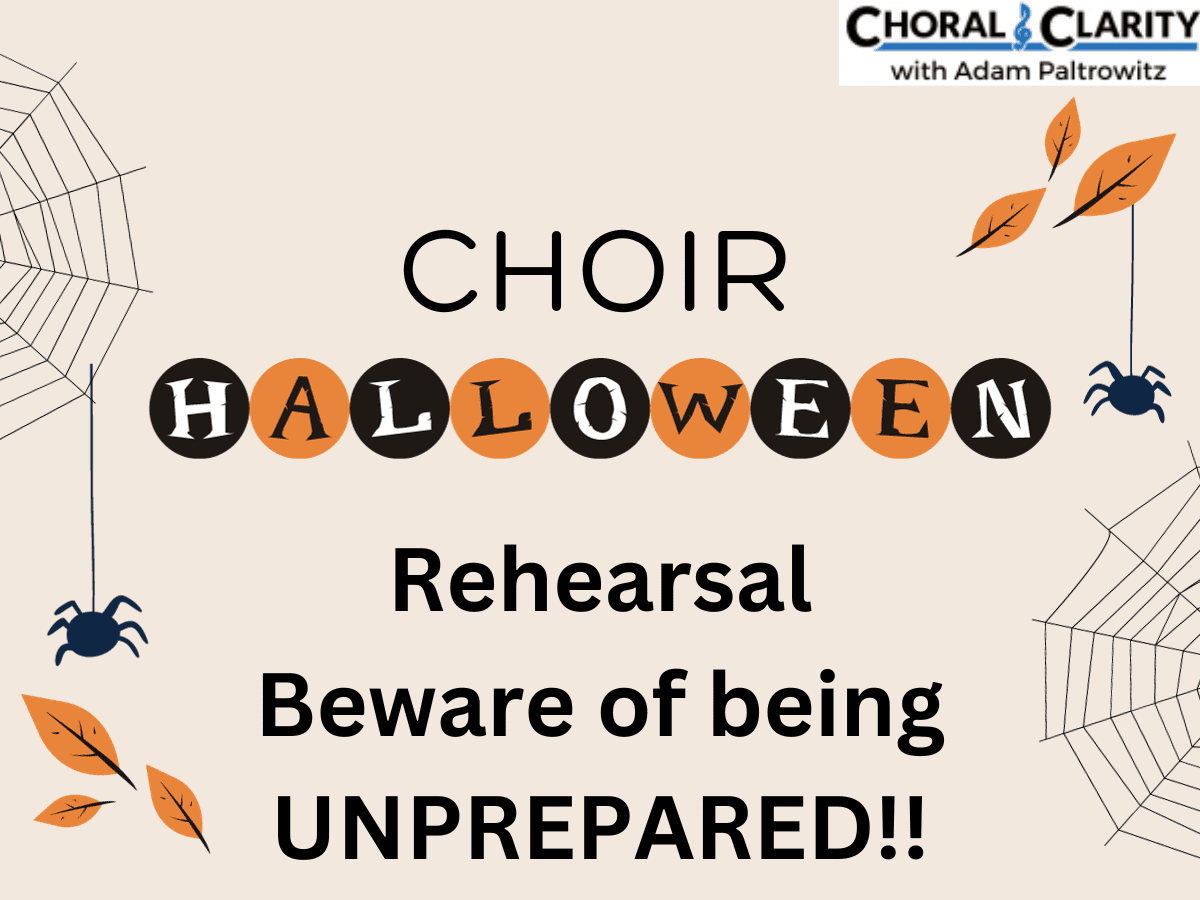For many of us, the New Year brings about a desire to make changes to our choral program; some examples of New Year changes would be: focusing more on daily sight-singing, reinforcing discipline, improving rehearsal focus, or improving the body alignment of our singers. Before you decide WHAT changes you wish to make, I suggest you focus on the big long-term WHY you want to make them.
Let me pose a challenge:
In one short paragraph, describe both your belief system and vision for your choral program:
Your answer to this question should be the driving force behind every decision you make for your program.
It’s so easy to think that whatever we currently do is the only way that could work in our given situation. When new ideas are presented to us, we may be quick to shoot them down because we believe we know what works best.
Rather than figuring out how to adapt a new idea into our current system, we dismiss the idea as something that could only work someplace else. The reality is, without a clearly defined belief system, we lack direction. Without direction, new ideas and/or approaches cannot effectively become implemented.
Try SIGHT READING FACTORY and save 10% using code: choralclarity
When do we generally make changes in our choral program?
Most of us make changes only when we feel backed into a corner. For the first decade of my teaching career, most changes in my program happened either out of utter necessity or completely by accident. While many of these changes helped to evolve my program, it took a long time before these changes took shape in a positive or effective manner.
Two examples:
Example A
Many years ago I formed a treble choir because there were way too many girls entering my program compared to the amount of boys. At the time, my program consisted of an unbalanced 10th-12th grade Mixed Choir, fed by an incredibly unbalanced freshman ensemble consisting of 3 boys and 20 girls.
Creating a 9th-10th grade treble ensemble allowed the 11th-12th grade female voices to balance with the males voices in 9th-12th grade; now four years of men are matched with the upper two years of women.
I was backed into a corner because both choirs were struggling as a result of the lack of basses and tenors. How could I continue to justify spending 50% of my rehearsal time on 3 men? How could we depend on 3 men to balance 20 women? Without making a change, my job became unrewarding and the quality of my program was dwindling.
Example B
One tradition that I inherited when I took over the program was caroling day: every year the mixed choir would go Caroling the day before the Winter break. They would usually perform at 2-3 nursing homes, and a few stores/banks (to receive choral donations.) This was a fun day for the students. The performances at the nursing homes were quite impactful but the performances at the stores and banks were painfully soul-sucking. In the banks, customers would literally walk through us with frustration as they reached the teller.
About 14 years ago, I arrived at school ready for a full day of caroling only to hear 3 voicemail messages waiting for me; there was a highly contagious illness that had spread among all 3 nursing homes at the same time and no visitors were permitted. I was thrown for a loop because my students were signed out for my field-trip and we had nowhere to sing.
I immediately called my Director of Music and together we decided to see if our four elementary schools would be interested in having us carol for them. All building principals loved the idea, and we found a caroling home for the day. This experience was so mutually wonderful, they begged us to come back the following year.
We knew the next year, there was no way we could perform at 4 elementary schools, 3 nursing homes, 2 banks, and a few stores. So we decided to make a shift. Instead, we performed at 2 nursing homes, one bank, and 4 elementary schools. But as the word spread in our district, the kindergarten center, two middle schools and central administration also wanted a stopover as well. At that point, we realized it was too much, so we decided to make yet another shift for the following year.
Our final Caroling Day evolution, which has been set for the past 12 years, moved the nursing home performances earlier in the season, dropped the soul-sucking, money-grabbing performances, and dedicated the entire day to Caroling within our district.
But even then, traveling to eight schools was really difficult to get to within an 8:30am-12:30pm time-slot with 90+ students on 2-3 buses. On top of that, it was really difficult to carol with such a large group; when we turned hallway corners, sometimes the choir ended up singing at different tempos and frequently the students in the back tended to lack focus. So after 5 years of musical mishaps, we decided to split our choir in half at each stop-off and have two student leaders direct each individual moving choir.
What these two examples have in common
While the way these changes have occurred are great for storytelling, they are more indicative of a lack of clear direction on my part. In regard to the forming of the treble choir, example a, it was met with a great deal of resistance from the school community. They believed I was punishing the 9th-10th grade girls by preventing their most talented students from being placed in the perceived top ensemble. The reality is that I did not present a clear vision to the community. I did not communicate the benefits of this change. All I did was explain the problem with the current situation and why this would solve that problem.
Why did we go caroling, example B? The program’s focus had been more about the WHAT and less on the WHY. We were accepting donations to pay for our well-earned pizza party later in the day. Some parents were annoyed that we were supporting corporate America. The purpose of our Caroling Day was too general; it was not deeply connected to my belief/vision of our choral program; it was just a fun thing to do.
When Caroling Day’s purpose became clearly defined and aligned with my big picture goals, it became far more successful and impactful.
Here are our current goals for Caroling Day:
- To spread joy throughout our district to all adults and children; we do this through positive interactions, making every choice with spreading joy as our priority, and by singing from our heart.
- To unify socially, emotionally, and musically as an ensemble
- To sing musically, expressively, and joyfully! (and knowing the correct words and notes)
When SHOULD we make changes to our program?
Here is the simple answer:
When we have a clear Belief System for our program, we will understand what aspects of our program are not effectively aligned. This is when we should make a change.
While some changes may need to happen due to a specific circumstance, a clear vision of purpose will more successfully guide any and all changes for long-term success.
Back to the challenge I posed earlier:
In one short paragraph, describe both your belief system and vision for your choral program:
For the purpose of this exercise, I am presenting my personal belief/vision for my program. This does not need to be the same as yours, but whatever you write down should be your guide for all decision-making.
My belief system/vision for my program
I believe anyone can learn to sing. Anyone who is willing to commit to the clear and attainable expectations of my choral program is welcomed. Within my program, students must learn to become self-aware of their individual strengths and weaknesses; this empowers them to become active learners who are self-motivated to grow. I believe in empowering student to be leaders whenever possible; the choral program should be able to function fully when I am not present, both in rehearsals and in concerts. As students become more vested, more opportunities should arise for them. Every student entering the program should be able to envision a four-year path filled with opportunities for musical growth, service, and leadership. Choir should leave an imprint on their lives and alumni should want to come back year after year.
Sih-Tih-Zihn – A song that will have meaning from the second you hand it out
available for SSAA or TTBB – $1.10 per copy
How a belief system/vision instills change?
Once we have a clearly defined belief system, the changes we make should always reflect those core beliefs.
In my choral program, I make changes whenever I realize some aspect of my program isn’t reflective of my belief system. I’ve eliminated traditions that didn’t fit my vision and created new traditions that I thought would move my program forward. Some things I’ve eliminated were auditioned choirs, social activities that lacked a clear goal, and in-school concerts where we sang our evening concert repertoire for the student body. Some things I added were student-run a-cappella ensembles, a treble choir for all 9th-10th grade treble voices, qualitative election ballots, senior sight-singing leaders, and student vocal directors.
I have continually improved my handbook, classroom guidelines and procedures, assessments and self-assessments, and how to handle individual conflicts that occur within my program.
As my program continually becomes more and more aligned with my belief system, the choir culture follows suit; the administrators, parents, community, and choir members all understand the vision of the choir. My pep talks, concert speeches, letters home, etc., all reflect a well-framed belief system.
Please join the Choral Clarity Facebook Community in order to converse together and share your vision!
What SHOULD we do before implementing any change?
The best thing to do is write out your belief system/vision for your program. Post it somewhere where you will see it day after day, and make sure it is truly what you believe and what you want your program to be. That is step 1. After that, use it to guide every future decision, and over time change anything in your choir culture that is misaligned.







Thank you so much. This is very wise. I couldn’t agree more.
I still have a few days of break, returning to school next week. Working on verbalizing belief/vision system for my program right now.
Thank you again and happy New Year!
Thank you for reading and sharing! I hope your New Year is off to a great start!